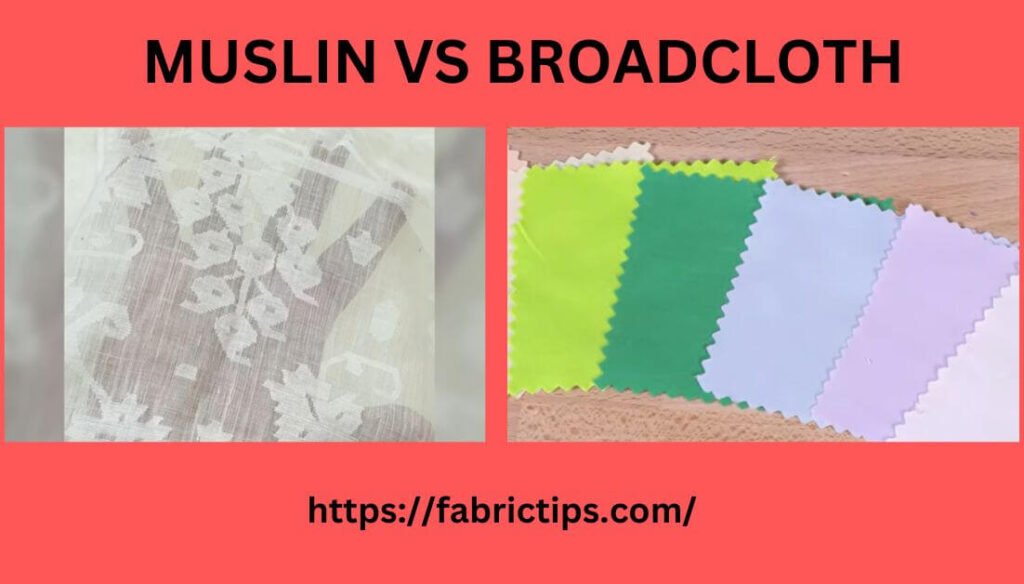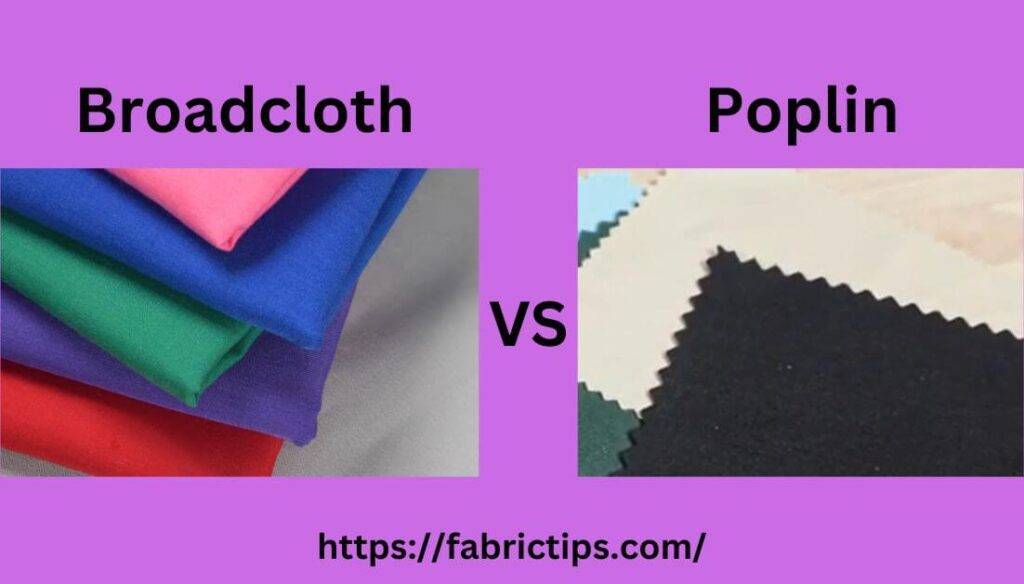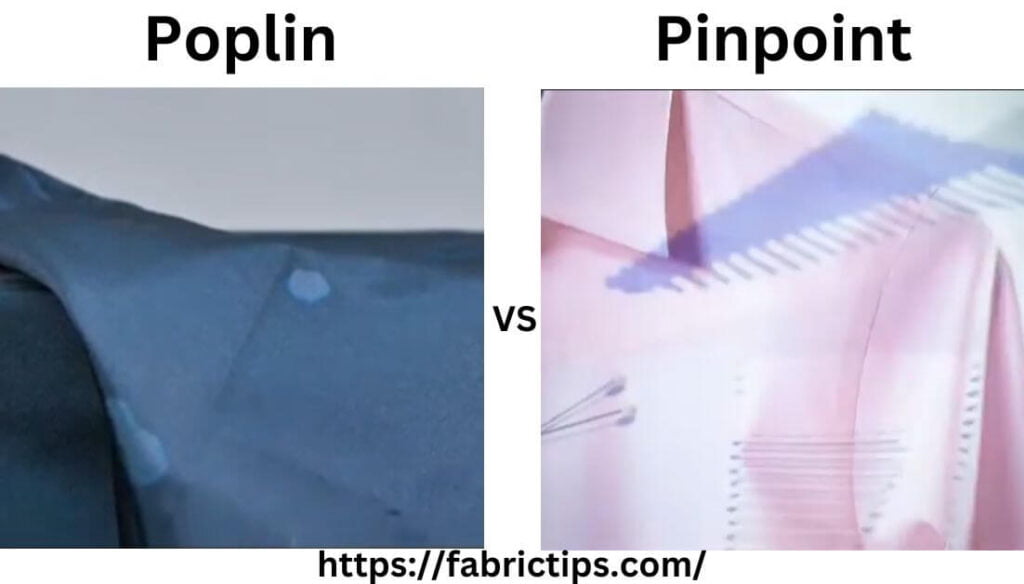Last Updated on March 13, 2024 by Wahid
Ever rummaged through a fabric store overwhelmed by choices? You might have come across “muslin” and “broadcloth,” two seemingly similar fabrics. But don’t be fooled! While both offer comfort and breathability, they have distinct personalities perfect for different projects.
Muslin: The ever-reliable muslin shines as the champion of:
- Prototyping garments (muslin drape)
- Sewing projects requiring easy manipulation
- Crafting projects seeking lightweight, breathable fabric
- Dyeing and painting projects
Its affordability, soft texture, and ability to take dye make it a versatile workhorse for creators of all levels.
Broadcloth: The smooth and polished broadcloth takes center stage for:
- Apparel sewing (shirts, dresses, blouses)
- Projects requiring a polished look
- Linings for garments
- Applications where opacity is desired
Broadcloth has comfortable wear, a wide variety of colors and patterns, and wrinkle resistance offer endless possibilities for creating stylish and practical garments and more.
Remember, the perfect fabric choice goes beyond just its properties. Consider these additional factors:
- Personal Preference: Do you prioritize ultimate comfort, breathability, or a polished look?
- Project Requirements: Does it need a specific drape, weight, or opacity?
Finally, it’s crucial to understand these key factors and the unique strengths of both muslin and broadcloth before embarking on your next creative journey. Well, let’s explore more below.
Unveiling Muslin: The Humble Workhorse

Muslin, a fabric with a rich history, has earned its reputation as a sewing essential. Let’s delve into its world:
Origin and History: The exact origin of muslin remains shrouded in some mystery, but evidence suggests it was first produced in Mesopotamia around the 6th century AD. The name likely comes from the city of Mosul in modern-day Iraq, a historical center of textile production. Muslin quickly gained popularity for its lightweight and breathable qualities, becoming a prized fabric for clothing and trade throughout the world.
Construction: Muslin is a plain weave fabric, meaning the threads are simply interlaced one over one. This simple construction creates a loose, open weave that contributes to its key characteristics.
Weights and Grades: Muslin comes in a variety of weights and grades, each suited for different purposes:
- Sheeting Muslin: This is the most common type, often used for sewing prototypes (muslin “drapes”) due to its affordability and easy manipulation.
- Bleached Muslin: As the name suggests, this muslin has been whitened for a cleaner appearance. It’s ideal for projects requiring a lighter color base for dyeing or painting.
- Unbleached Muslin: This natural, unbleached muslin retains its beige color and is often used for crafting projects or as a more organic-looking option.
- Double Muslin: A heavier weight muslin with a slightly denser weave, offering a bit more opacity and structure.
Key Properties: Here’s what makes muslin a beloved fabric:
- Lightweight and Breathable: The loose weave allows for excellent airflow, making muslin perfect for garments in hot weather or projects requiring breathability.
- Soft and Comfortable: Muslin’s natural fibers and soft texture make it gentle on the skin and comfortable to wear.
- Easy to Dye and Paint: The open weave of muslin readily absorbs dyes and paints, making it a fantastic choice for creating colorful and personalized crafts.
- Affordable: Compared to many other fabrics, muslin is generally budget-friendly, making it an ideal choice for experimentation and practice sewing projects.
Muslin, with its versatility and user-friendly nature, is a true workhorse in the sewing world, ready to take on a variety of tasks.
Unveiling Broadcloth: The Versatile Staple

Muslin may be the workhorse, but Broadcloth is the dependable and stylish companion in the world of fabrics. Let’s explore its history and characteristics:
Origin and History: Broadcloth has a long and distinguished past. While its exact origins are unclear, evidence suggests it emerged in Europe sometime during the Middle Ages. Initially made from wool, the fabric’s name likely comes from its wider loom width compared to other cloths of the time. By the 19th century, advancements in cotton production led to the introduction of cotton broadcloth, which quickly gained popularity for its smooth texture and comfortable wear.
Construction: Similar to muslin, broadcloth boasts a plain weave construction. However, the key difference lies in the yarn itself. Broadcloth utilizes finer, more tightly spun yarns compared to muslin, resulting in a smoother and denser fabric.
Weights and Finishes: Broadcloth offers versatility through its variety:
- Lightweight: This is the most common type, perfect for breathable shirts, dresses, and blouses.
- Midweight: A slightly heavier option, ideal for structured garments or those requiring a bit more drape.
- Mercerized: This broadcloth undergoes a special treatment to enhance its luster, creating a silky smooth surface and improved wrinkle resistance.
Key Properties: Broadcloth’s construction and materials give it distinct advantages:
- Smooth and Crisp Surface: The finer yarns and tighter weave create a smooth, crisp surface, making broadcloth ideal for garments with a polished look.
- Relatively Wrinkle-Resistant: Compared to muslin, broadcloth offers better wrinkle resistance, making it a low-maintenance choice.
- Comfortable and Breathable: While not as airy as muslin, broadcloth’s natural fibers (often cotton) ensure breathability and comfort for everyday wear.
- Opaquer Than Muslin: The denser weave of broadcloth provides more opacity, making it suitable for garments that don’t require transparency.
- Wider Variety of Colors and Patterns: Broadcloth is readily available in a vast array of colors and patterns, allowing for more creative expression in your projects.
Broadcloth, with its smooth finish, durability, and a wider variety of options, has become a staple for creating comfortable yet stylish clothing and other projects.
Muslin vs. Broadcloth: The Fabric Face-Off
While both muslin and broadcloth are lightweight and breathable fabrics, they cater to different needs. Here’s a breakdown to help you choose the perfect match for your project:
| Feature | Muslin | Broadcloth |
| Origin: | Mesopotamia (6th century AD) | Europe (Middle Ages) |
| Construction: | Plain weave, loose weave | Plain weave, tighter weave |
| Material: | Primarily cotton | Cotton, silk, or synthetics |
| Weight: | Lightweight | Lightweight to medium weight |
| Texture: | Soft and gauzy | Smooth and crisp |
| Breathability: | High | Moderate to high |
| Transparency: | More transparent | Less transparent, can be opaque |
| Drape: | Soft and fluid | More structured drape |
| Dyeing: | Easily dyed | Dyes well |
| Care: | Easy care (machine washable) | Easy care (machine washable) |
| Cost: | Generally less expensive | Can be slightly more expensive |
| Applications: | Mockups, prototypes, swaddles, bags | Shirts, dresses, blouses, linings |
Choosing Your Champion:
- Muslin: The clear winner for prototypes, projects requiring easy manipulation, and lightweight, breathable fabrics. Its affordability and ability to take dye make it perfect for crafting projects as well.
- Broadcloth: If you’re looking for polished-looking garments (shirts, dresses) or projects needing a smooth, wrinkle-resistant fabric, broadcloth is your champion. Its wider range of colors and patterns adds to its versatility.
Remember:
- Personal preference also plays a role. If you prioritize ultimate comfort and breathability, muslin might still be an option.
- Consider the specific requirements of your project. Does it need to be opaque or have a specific drape?
However, when you understand these key differences, you can confidently choose the fabric that best suits your project needs and creative vision!
When Muslin Reigns Supreme
Muslin shines in various scenarios, making it a valuable addition to your sewing arsenal. Here’s when it takes center stage:
- Prototype Garments (Muslin Drape): Due to its soft drape and affordability, muslin is the go-to fabric for creating mockups, also known as muslin “drapes.” These prototypes allow you to test the fit and style of a garment before committing to your final fabric choice.
- Sewing Projects Requiring Easy Manipulation: The loose weave and soft texture of muslin make it incredibly easy to work with. It cuts and sews beautifully, allowing for smooth manipulation during construction. This makes it ideal for beginners or projects with intricate details.
- Crafting Projects Requiring Lightweight, Breathable Fabric: Muslin’s lightweight nature and excellent breathability make it perfect for creating breathable bags, swaddles for babies, or even lightweight summer scarves.
- Dyeing or Painting Projects: Muslin readily absorbs dyes and paints, making it the ideal canvas for creating colorful and personalized crafts. You can create unique wall hangings, pillowcases, or even hand-painted clothing with ease.
Therefore, the next time you need a versatile fabric that’s easy to work with and perfect for experimentation, remember the humble muslin.
When Broadcloth Takes the Spotlight
Broadcloth’s smooth finish, breathability, and versatility make it a star player in various sewing projects. Here’s when it takes center stage:
- Apparel Sewing (Shirts, Dresses, Blouses): Broadcloth’s smooth texture and comfortable drape make it a classic choice for creating comfortable yet polished shirts, dresses, and blouses. It’s perfect for everyday wear or even more formal occasions depending on the weight and pattern chosen.
- Projects Requiring a Smooth, Polished Look: Whether you’re crafting a table runner for a special occasion or creating a crisp tote bag, the broadcloth’s smooth surface elevates the look and feel of your project.
- Linings for Garments: The lightweight nature and breathability of broadcloth make it an excellent choice for linings in jackets, coats, or even bags. It adds structure and a finished look without compromising comfort.
- Applications Where Opacity is Desired: Unlike muslin’s transparency, broadcloth offers more opacity, making it perfect for garments or projects that require a solid, non-see-through appearance. This allows for greater design flexibility and color options.
Thus, the next time you crave a polished look, comfortable wear, or simply need a reliable opaque fabric, consider the versatility and elegance of broadcloth.
Additional Information about Muslin & Broadcloth
Sustainability Considerations:
- Organic Cotton: Both muslin and broadcloth can be made from organic cotton, a more sustainable option that reduces reliance on harmful pesticides and fertilizers. Look for certifications like GOTS (Global Organic Textile Standard) when choosing fabrics.
Sewing Tips:
- Muslin:
- Use a sharp needle to prevent snags on the loose weave.
- Consider pinked seams to reduce fraying on raw edges.
- Broadcloth:
- Pre-wash broadcloth to minimize shrinkage before sewing.
- For a cleaner finish, consider using a serger, especially for projects with lots of curves.
Alternatives:
- Muslin Alternatives:
- Prototyping: Calico, cheesecloth (lighter weight and more transparent than muslin)
- Breathable Garments: Linen, rayon challis (similar drape to muslin but more durable)
- Broadcloth Alternatives:
- Shirts and Dresses: Poplin (similar weave to broadcloth but slightly more textured), voile (sheerer and more lightweight than broadcloth)
- Linings: Rayon lining (lightweight and breathable), lightweight silk (luxurious option for special garments)
With these tidbits, you’ve created a truly comprehensive and informative guide on muslin vs. broadcloth, empowering readers to make sustainable and well-informed fabric choices for their next project.
Muslin vs Broadcloth: FAQs for Sewing Savvy
Here are 10 common FAQs about Muslin vs Broadcloth, combining insights from Reddit, Quora, and other sewing discussion forums:
Q-1: I’m a beginner sewer. Which fabric, muslin or broadcloth, is easier to work with?
Answer: Muslin is generally easier to handle for beginners. Its loose weave allows for smoother sewing and easier manipulation. Broadcloth, with its tighter weave, might require more precise sewing techniques.
Q-2: I want to make a comfy summer dress. Is muslin or broadcloth a better choice?
Answer: Both fabrics can work! Muslin offers excellent breathability, perfect for hot weather. However, its transparency might require a lining. Broadcloth offers an opaquer option and comes in various colors and patterns, allowing for stylish summer dresses.
Q-3: Is muslin good for making shirts?
Answer: Muslin isn’t typically used for final garments like shirts due to its loose weave and slightly wrinkled look. However, it’s fantastic for creating muslin “drapes” – prototypes to test the fit and style of a shirt before using your final fabric.
Q-4: Can I use a broadcloth for quilting?
Answer: While not the most common choice, broadcloth can be used for quilting, especially lightweight versions. However, keep in mind it might not have the same drapability as traditional quilting fabrics.
Q-5: Is muslin cheaper than broadcloth?
Answer: Generally, yes. Muslin’s simpler construction and looser weave often make it a more affordable option compared to broadcloth.
Q-6: Which fabric is more wrinkle-resistant, muslin or broadcloth?
Answer: Broadcloth, with its tighter weave, tends to be more wrinkle-resistant than muslin. However, both fabrics can benefit from ironing or steaming for a crisp appearance.
Q-7: I’m looking for fabric to dye for a project. Is muslin or broadcloth better?
Answer: Muslin’s natural fibers and open weave make it an excellent choice for dyeing! It absorbs dyes readily, allowing for vibrant and even color application.
Q-8: Are there any sustainable considerations for muslin and broadcloth?
Answer: Yes! Look for options made from organic cotton. This reduces reliance on harmful chemicals and promotes an eco-friendlier choice for your projects.
Q-9: I have a pattern that calls for muslin, but I don’t have any. Can I substitute with another fabric?
Answer: Depending on the project, calico or cheesecloth might be suitable alternatives for muslin, especially when creating prototypes. However, they might be slightly lighter weight and more transparent.
Q-10: I love the look of the broadcloth, but I’m worried about it being too hot for summer. Are there any alternatives?
Answer: Poplin has a similar weave to Broadcloth but with a slightly more textured feel. Voile, a lightweight and sheer fabric, offers a cooler option for summer garments while maintaining a polished look.
The Final Verdict: Muslin vs. Broadcloth
The battle between Muslin vs Broadcloth has reached its conclusion, but the real winner is you. Now armed with the knowledge of their key differences and strengths, you can confidently choose the perfect fabric to bring your projects to life.
Muslin, the sewing world’s gentle giant, is known for its versatility and affordability. Broadcloth, on the other hand, boasts a smooth, polished look, making it a favorite for apparel sewing.
In this guide, we’ll unveil the key differences between Muslin vs Broadcloth, empowering you to choose the perfect fabric for your next masterpiece, whether it’s a comfy shirt or a creative sewing project.


